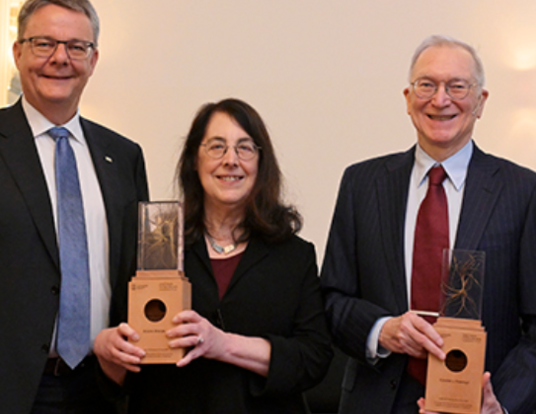Evolving Relationships, Evolving Borderlands
Two great powers, a borderland, and a souring relationship

Research at Risk: Since World War II, universities have worked with the federal government to create an innovation ecosystem that has yielded life-changing progress. Now much of that work may be halted as funding is withdrawn. Find out more about the threats to medical, engineering, and scientific research, as well as how Harvard is fighting to preserve this work—and the University's core values.
As war rages on in Ukraine, western leaders and diplomats fret about Russia's relationship with China, a country with growing influence in Asia and around the world. Yipeng Zhou, who will graduate this month with an AM in regional studies from Harvard’s Graduate School of Arts and Sciences (GSAS) points out that the dynamics between China and the Soviet Union, in which Russia was by far the largest and most powerful republic, changed and shifted over the course of the 20th century. He studies the history of Xinjiang, China’s northwestern borderland in Central Asia, to understand the evolving political and academic relationship between the two great powers.

Zhou’s thesis, “Research on Frontiers: Sino-Soviet Knowledge Campaigns on the Central Asian Borderland,” covers the years between the 1950s and the 1980s. His work runs counter to the existing consensus that Chinese communist state-building passively copied the Soviet style of governance and shows that relations between the two nations went from friendly to sour over the course of three decades.
The Xinjiang territory that Zhou studies has close historical ties to imperial Russia and Soviet Central Asia; as a result, the region was controlled by Moscow until the Chinese communists came to power in the mid-20th century.
“On the eve of 1949, the Soviets said to the Chinese that they would relinquish Xinjiang,” Zhou says. “But the Chinese communists had no experience governing in this region. They knew very little about it. And so, in the 1950s, during a period of Sino-Soviet friendship, the Soviets helped them out in developing this new borderland.”
After the power transfer, Zhou says, the Soviets sought to teach their fellow communist neighbors how to govern the region. They sent experts to develop industries in the region as well as social scientists, primarily linguists, and ethnographers, to help the Chinese with research on the minority ethnic groups in Xinjiang: the Uyghurs, Kazakhs, Tajiks, Mongols, and others. Zhou says this assistance promoted a Soviet understanding of the borderland, which was based on the idea of territorialized ethnicity.
“The Soviet Union was divided into different national republics—the Russian republic, Kazakhstan, Tajikistan, Uzbekistan, Turkmenistan, and so on,” he says. “In each republic, there was a dominant nationality. The Soviets saw the land as ‘The Russians have lived here since ancient times, so this is Russian land; the Kazakhs have lived there since ancient times, so that’s the Kazakh land.’” Under the influence of this idea of territorialized ethnicity, the Chinese viewed Xinjiang as an ethnic land throughout the 1950s. The Chinese study of the region during that period was simply the study of national minorities there.
However, following the souring of relations with the Soviet Union, especially around territorial disputes, the Chinese began to develop their own vision of Xinjiang. “After the 1960s, the Chinese turned away from the Soviet ethnicity-centered understanding of borderland. They focused more on borderland security and territorial integrity,” Zhou says.
This shift in thinking about territory also impacted how China treated Xinjiang. For example, the Soviet Union empowered ethnic majorities in its republics and blamed the Chinese for not doing the same in Xinjiang with the Uyghurs. Soviet republican leaders were usually from the titular nationalities—Russians in Russia, Ukrainians in Ukraine, Kazakhs in Kazakhstan, and so on. In most national republics, those who were not members of the titular nationality often faced discrimination. Republics were, in theory, even given the right to separate from the Soviet Union, though none dared to break with Moscow until the collapse of the USSR in 1991. This promise of national self-determination, even on paper, was never given to non-Han minorities in Xinjiang.
“The Chinese leaders thought they could not give this right of national self-determination because what is more important in China is territorial integrity and political unity,” Zhou says. “Although Xinjiang is an autonomous region, Chinese leaders are very clear that it does not mean Uyghurs are the only ones who have control over the territory.”
Following the Cultural Revolution and into the 1970s, Zhou says that Chinese scholars tried to de-emphasize ethnic differences in Chinese territories.
“In the 1970s, they begin to say, ‘This [Xinjiang] is just Chinese territory,” Zhou says. “It is no different than any other Chinese territory. They begin to develop this perception that focuses on borderland and territory security.”
After the 1960s, the Chinese turned away from the Soviet ethnicity-centered understanding of borderland. They focused more on borderland security and territorial integrity.
-Yipeng Zhou, AM ’22
As the Chinese continued to evolve their understanding of territory, nationality, and Xinjiang, the Soviet Union maintained its stance of viewing territory through ethnicity. Following the Sino-Soviet split, Soviet scholars found the Uyghurs an exploitable agent in their ideological rivalry with China in Central Asia and began to emphasize the idea of Xinjiang as Uyghur land. They even developed a new academic subject, Uyghur studies, in support of the Soviet stance in debates over Central Asian questions. “For the Soviets, the guiding idea for their research is this territorialized ethnicity,” Zhou says. “Soviet scholars argued that Xinjiang is Uyghur land.”
Zhou’s thesis ends in the 1980s when China opened up to reforms and liberalized academia to some extent. Zhou cites a book written by a Han Chinese scholar on the history of the Uyghurs.
“It is very telling that the first history of Uyghurs in China was written by a Han Chinese scholar in two languages, Uyghur and Chinese,” Zhou says. “That doesn’t mean a return to the Soviet school of thought, but it does mean a return to research on ethnicity in a good sense.”
Despite the cooling of relations that occurred between the Soviets and the Chinese shown in Zhou’s research, he says that currently, Russia and China have stronger ties that better resemble their relationship at the beginning of Zhou’s period of study.
“Today, China’s policy towards Russia makes me feel like we’re back in the 1950s,” he says. “The mainstream discourse is pro-Russian.”
Photos courtesy of Yipeng Zhou
Get the Latest Updates
Join Our Newsletter
Subscribe to Colloquy Podcast
Simplecast





